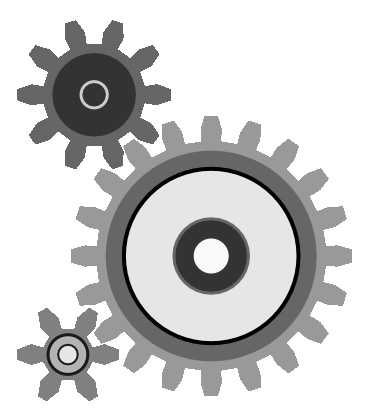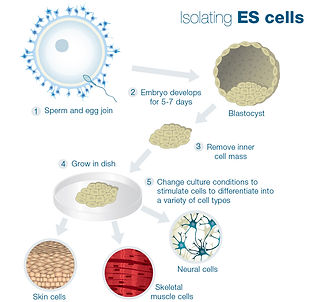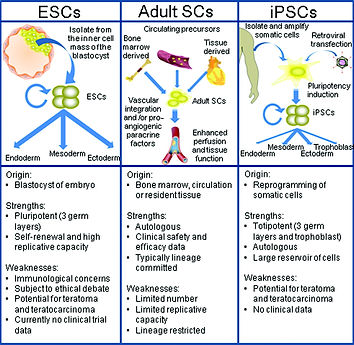Regenerative Medicine
The cure of the future.
WHAT ARE STEM CELLS?
Think of the human body as a factory. In essence, it is an intricately organized structure that
has a constant stream of input, in the form of food and nutrients, and output, in the form of the
various tasks we complete every day. The link between the input and output is the body’s
network of organ systems - the circulatory system, the musculoskeletal system, the immune (5)
system,and other such systems all work together to help humans live their lives. However, every factory requires an adequate supply of raw materials to build and maintain the various internal structuresthat keep the factory functioning.
In this analogy, stem cells are the body’s raw materials, the cells from which all other cells with specialized functions are generated (1). In order to have the label “stem cell”, there are twocriteria that need to be met (3).
1. The cell must be able to self-renew, which is the ability to replicate itself into the same non-specialized cell type for long periods of time (many months to years).
2. The cell must be able to differentiate, which is the ability of an unspecialized cell to acquire the features of a specialized cell, such as a heart, liver, or muscle cell. Differentiation is controlled by the interaction of a cell’s genes with the physical and chemical conditions outside the cell (4).
There are two main sources for stem cells - embryos formed during the blastocyst
phase of embryological development (called human embryonic stem cells or
hESCs) and adult tissue (called adult stem cells or somatic stem cells). Each
type has a specific potential to differentiate into another cell type, called
potency (2).
1. http://www.mayoclinic.org/tests-procedures/stem-cell-transplant/in-depth/
stem-cells/art-20048117
2. http://www.medicalnewstoday.com/info/stem_cell/
3. http://www.ncbi.nlm.nih.gov/pubmed/18369744 (6)
4. http://stemcells.nih.gov/StaticResources/info/popups/glossary.html#ltrenewal
5. http://www.juntadeandalucia.es/averroes/eltejar/images/automatas/fk36vn.gif
6. http://upload.wikimedia.org/wikipedia/commons/3/3c/Stem_cells_diagram.png


HOW ARE STEM CELLS CHARACTERIZED?


At this point, a doctor or researcher may isolate the embryonic stem cells by placing the inner cell mass into a culture dish with a nutrient-rich media that will prevent the stem cells from differentiating further. From this culture dish, the doctor or researcher can culture a colony of undifferentiated, pluripotent stem cells for research or therapeutic purposes. The controlled culture of healthy, dividing, and undifferentiated cells is called a stem cell line (2).
There are many levels of potencies amongst stem cells. The
first level is called totipotent, which is the most versatile of the
stem cell types. The totipotent cells are the cells of the zygote
which is the first stage of embryonic development, when the
sperm cell fertilizes the egg cell. For up to three days, this
zygote divides more and more, creating more cells that have
the potential to give rise to virtually every single human cell,
whether it is a brain cell, bone cell, or another stem cell. After
approximately four days, the totipotent cells of the zygote
differentiate into a second level of more specialized cells (1).
This level of potency is called pluripotent, and occurs in a
mass of cells called the blastocyst. The blastocyst consists of
two parts: an inner cell mass (called the embryoblast) and the (10)
outer cell mass (called the trophoblast). The outer cell mass will form the placenta, while the inner cell mass will form the actual internal organs of the baby. Specifically, this inner cell mass is the source of the pluripotent, embryonic stem cells (2). However, embryonic stem cells are almost always extracted from eggs donated to IVF, or in-vitro fertilization, clinics. As opposed to in-vivo, which is fertilization of the egg inside the body, in-vitro is fertilization of the egg outside of the body (8). Embryonic stem cells can only be isolated from eggs that have not been implanted into the woman’s uterus and can only be donated via informed consent (5).
HOW ARE THEY ISOLATED?
(11)
ISOLATION OF MSC'S FROM MOUSE BONE
(12)
WHAT ARE THE OTHER CLASSIFICATIONS?
(13)
WHAT ARE IPSC's? AND MORE...
Further along the potency spectrum is the multipotent stem cell. Multipotent stem cells are characterized by their ability to differentiate into a closely related family cells, and they occur when the fetus has further developed and begins to form internal structures. Examples of multipotent cells include hematopoietic stem cells which will go on to become red or white blood cells or platelets (2). Adult stem cells are also considered multipotent, because they can develop into more than one cell type as needed, but are more limited than pluripotent stem cells (3).
More specifically, an adult stem cell is an undifferentiated cell found among differentiated cells in a tissue or organ. These cells can divide and differentiate into mature cell types that are characteristic of specialized tissue (5). Interestingly, recent research has shown that adult stem cells can differentiate into cell types that unrelated to their predicted lineage, a process called transdifferentiation. For instance, hematopoietic stem cells can give rise to cardiomyocytes which are heart muscle cells. Moreover, scientists are now being able to reprogram certain adult stem cells to differentiate a certain way. This variation of transdifferentiation has many applications, such as reprogramming pancreatic cells to differentiate into pancreatic beta cells, the insulin-producing cells that are lost or damaged in diabetes (6). Perhaps the most ground-breaking advancement in the reprogramming of adult stem cells is the creation of induced-pluripotent stem cells (iPSCs).

iPSCs are adult stem cells that have been genetically reprogrammed to act like an embryonic stem cell. As such, they can self-renew and can differentiate into all cell types of the body except for cells in the extra-embryonic tissues such as the placenta. While there are many similarities between induced-pluripotent and embryonic stem cells when applied, there are some key differences. Mainly, iPSCs do not require cells from an early embryo, which bypasses the many obstacles required to obtain embryonic stem cells. Additionally, induced-pluripotent stem cell therapies can transform organ transplantation, as these cells originate from adult stem cells in the transplant recipient’s own body, thereby preventing immune rejection. However, due to their relatively recent discovery, which can be further explored here [insert link to timeline], scientists are still unsure of the genetic differences between iPSCs and actual embryonic stem cells. As such, further research is required in the field before these types of stem cells can be used in regenerative medicine on a wider scale (9).
(14) (15)
The next level of potency is called oligopotent, which is the ability to differentiate into a few cells, and also occurs as adult stem cells (2). Some oligopotent stem cells include lymphoid or myeloid stem cells, which are derivatives of hematopoietic stem cells that form red blood cells, and other immune system-related cells (4).
The final level of potency is unipotent, which is the ability to produce only cells of one type. However, unipotent cells are considered stem cells because they have the property of self-renewal which is necessary for the “stem cell” label. Unipotent cells, such as muscle stem cells, occur as adult stem cells (2).
1.http://www.explorestemcells.co.uk/totipotentstemcells.html
2.http://www.medicalnewstoday.com/info/stem_cell/
3.http://stemcell.ny.gov/faqs/what-difference-between-totipotent-pluripotent-and-multipotent
4.http://www.keystonesymposia.org/13A4
5.http://www.mayoclinic.org/tests-procedures/stem-cell-transplant/in-depth/stem-cells/art-20048117
6.http://stemcells.nih.gov/info/basics/pages/basics4.aspx
7.http://www.nature.com/subjects/induced-pluripotent-stem-cells
8.http://www.givf.com/fertility/ivf.shtml
9.http://www.eurostemcell.org/factsheet/ips-cells-and-reprogramming-turn-any-cell-body-stem-cell]
10. http://stemcellres.com/content/figures/scrt83-1-l.jpg
11.http://learn.genetics.utah.edu/content/stemcells/quickref/es-cells.jpg
12. https://www.youtube.com/watch?v=Dnvq_wMZ2fI
13. http://circ.ahajournals.org/content/122/5/517/F1.large.jpg
14. http://murphylaboratory.com/wp-content/uploads/2013/01/Clinical-Trial2.jpg
15. http://www.ucdmc.ucdavis.edu/stemcellresearch/images/home/research1.jpg


